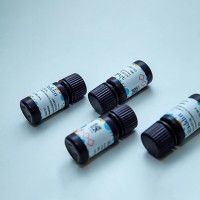Validation of Tandem Mass Spectrometry Database Search Results Using DTASelect
互联网
- Abstract
- Table of Contents
- Figures
- Literature Cited
Abstract
DTASelect provides a means by which complex SEQUEST results can be filtered, organized, and viewed. A single sample may produce tens of thousands of tandem mass spectra. Manually perusing and selecting SEQUEST matches among such a mass of data carries a risk of inconsistency. DTASelect allows the user to set complex criteria for acceptance or rejection of individual spectrum results. It also features rules for dealing with multiple, identical peptide matches and for removing proteins that are insufficiently evidenced. It provides its sorted and filtered summary as HTML and text documents for easy review and also offers several auxiliary reports. DTASelect is a powerful tool for automatic analysis of complex mixture tandem mass spectrometry.
Keywords: tandem mass spectrometry; database searching; statistical validation; data filtering.
Table of Contents
- Basic Protocol 1: Using DTASelect to Analyze and Display Sequest Results
- Support Protocol 1: Downloading and Installing DTASelect
- Guidelines for Understanding Results
- Commentary
- Literature Cited
- Figures
- Tables
Materials
Figures
-
Figure 13.4.1 Example of main DTASelect output (DTASelect.html). Each protein is listed in red (for example, the second from the top is ENSRNOP00000020364), followed by the number of its supporting peptides (each listed in blue on a separate line, in this case 4), followed by the number of spectra (for this particular protein, 6 + 2 + 1 + 8 = 17), its sequence coverage (21.2%), length of the sequence (278), molecular weight (31,095), approximate pI (5.4), and descriptive name. View Image -
Figure 13.4.2 Example of a summary table listed at the bottom of the DTASelect.html file. The Unfiltered row represents raw output from SEQUEST. The Filtered row represents output that has passed DTASelect filtering criteria and is displayed on the screen. This is further split into forward database matches and decoy database matches (for example, out of the 10,000 spectra validated by DTASelect, 9,985 match the forward database and 15 match the decoy database). The last row of the table displays the false positive rate of DTASelect for proteins (1.36%), peptides (0.37%), and spectra (0.15%). View Image -
Figure 13.4.3 Example of a modification report DTASelect‐mods.html. The header of the file in the figure describes the meaning of the columns. View Image -
Figure 13.4.4 Sample of DTASelect's GUI displaying a spectrum. Spectra can be viewed directly from the compressed files or from .dta or .ms2 files. Clicking on the name of a spectrum in the list (the one highlighted in yellow) will display it in the viewing window. The red and blue peaks represent peptide b and y ions, respectively. View Image -
Figure 13.4.5 SpectrumApplet CGI displaying a spectrum. The sequence shown is the doubly charged HELSSLADVYINDAFGTAHR, with a precursor M + H of 2217.4026. The red and blue peaks represent peptide b and y ions, respectively. View Image -
Figure 13.4.6 Sample BirdsEye Graphic for Yeast Proteome Sample. This example uses classifications to separate the proteins of the yeast_orfs database into six classes on the basis of mass, leaving a few of the smallest proteins unclassified. Each protein in the database is represented by a small block. The size of the protein determines to which class the block belongs, while its sequence coverage is represented by the color of the block. The color heat map legend is shown at the bottom of the figure. View Image
Videos
Literature Cited
| Eng, J., McCormack, A.L., and Yates, J.R. 1994. An approach to correlate tandem mass spectral data of peptides with amino acid sequences in a protein database. J. Am. Soc. Mass Spectrom. 5:976‐989. | |
| Keller, A., Nesvizhskii, A.I., Kolker, E., and Aebersold, R. 2002. Empirical statistical model to estimate the accuracy of peptide identifications made by MS/MS and database search. Anal. Chem. 74:5383‐5392. | |
| McDonald, W.H., Tabb, D.L., Sadygov, R.G., MacCoss, M.J., Venable, J., Graumann, J., Johnson, J.R., Cociorva, D., and Yates, J.R. 2004. MS1, MS2, and SQT: Three unified, compact, and easily parsed file formats for the storage of shotgun proteomic spectra and identifications. Rapid Commun. Mass Spectrom. 18:2162‐2168. | |
| Nesvizhskii, A.I., Keller, A., Kolker, E., and Aebersold, R. 2003. A statistical model for identifying proteins by tandem mass spectrometry. Anal. Chem. 75:4646‐4658. | |
| Peng, J., Elias, J.E., Thoreen, C.C., Licklider, L.F., and Gygi, S.P. 2003. Evaluation of multidimensional chromatography coupled with tandem mass spectrometry (LC/LC‐MS/MS) for large‐scale protein analysis: The yeast proteome. J. Proteome Res. 2:43‐50. | |
| Tabb, D.L., McDonald, W.H., and Yates, J.R. 2002. DTASelect and Contrast: Tools for assembling and comparing protein identifications from shotgun proteomics. J. Proteome Res. 1:21‐26. | |
| Washburn, M.P., Wolters, D., and Yates, J.R. 2001. Large‐scale analysis of the yeast proteome by multidimensional protein identification technology. Nat. Biotechnol. 19:242‐247. | |
| Key References | |
| Tabb et al., 2002. See above. | |
| The original description of the DTASelect algorithm. | |
| Internet Resources | |
| http://fields.scripps.edu/DTASelect/index.html | |
| This is the official DTASelect site. It contains user manuals, as well as various examples and screenshots. Software updates are also posted on this site, along with instructions on how to download the latest version of the software. |






